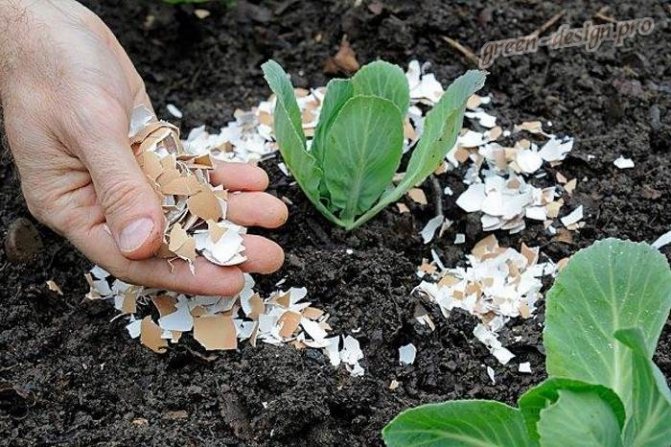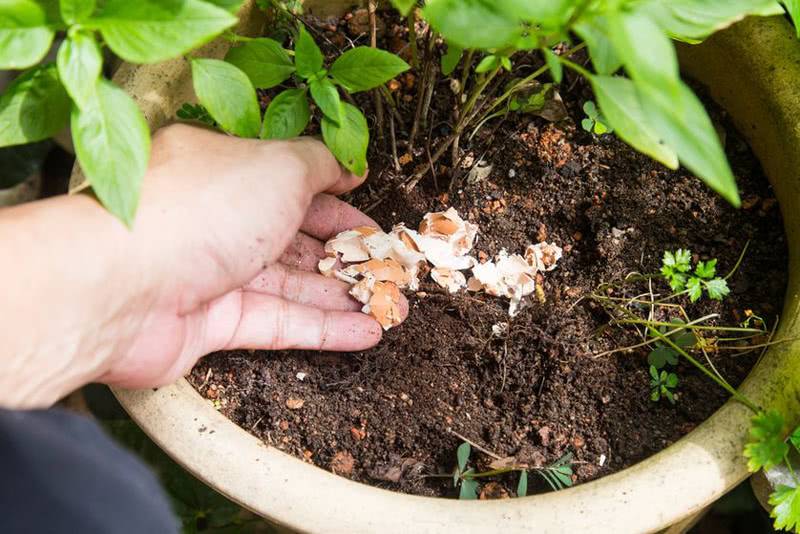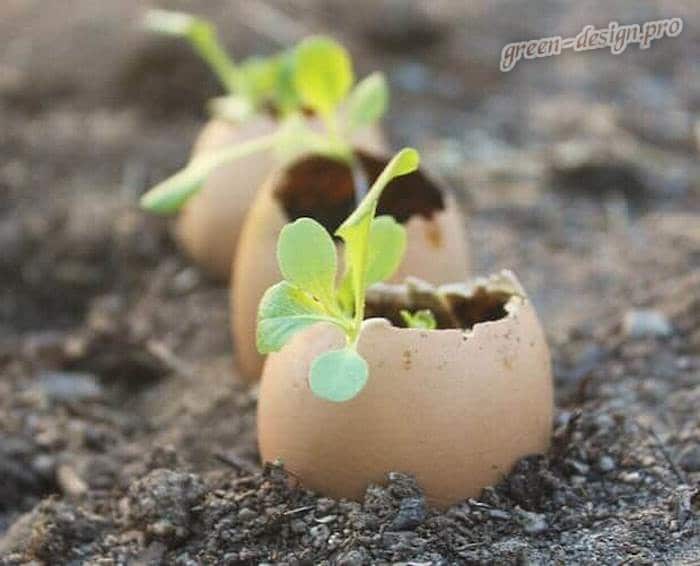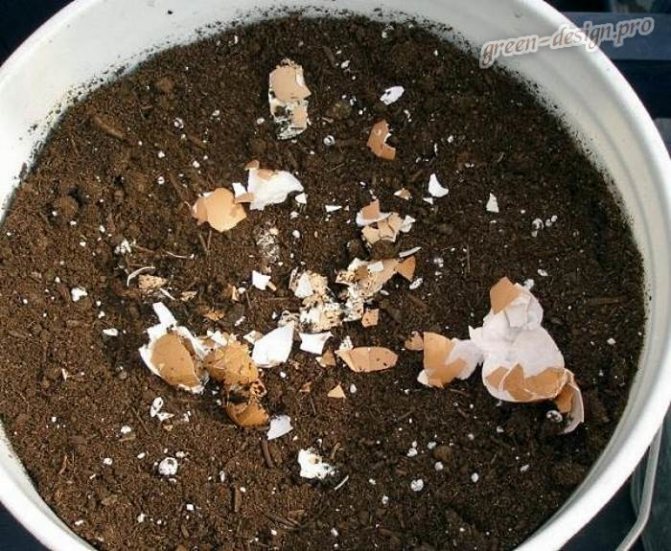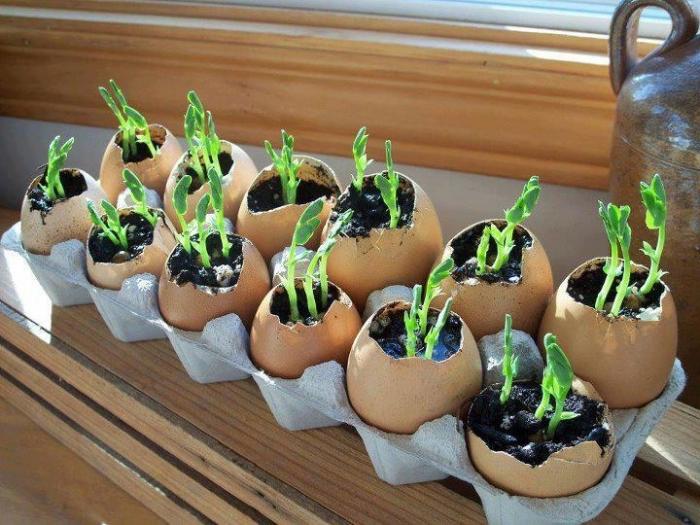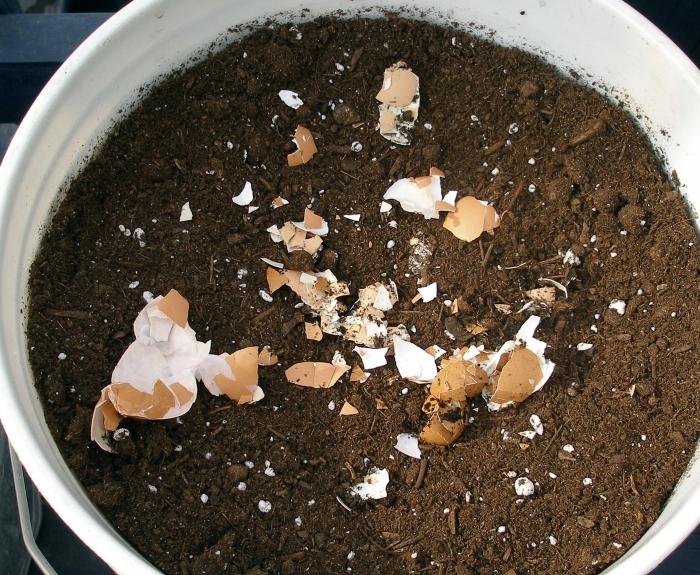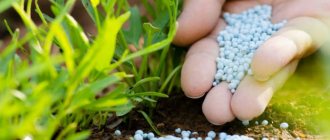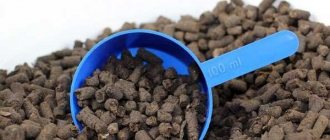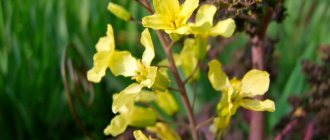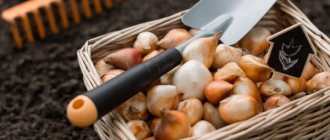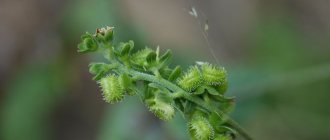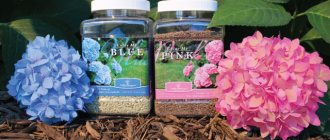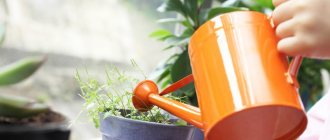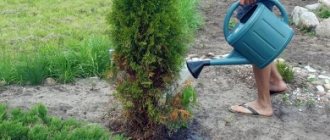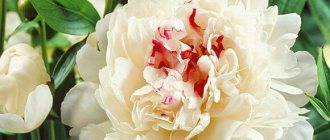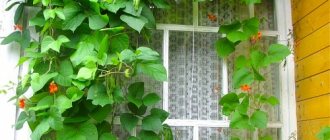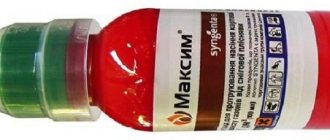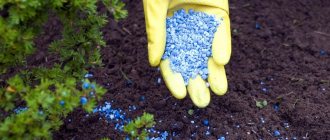Eggshell composition and structure
The structure of the shell is a crystal lattice, consisting mainly of calcium carbonate (more than 90% of the total composition).
As additional substances, it contains:
- nitrogen;
- sulfur;
- iron;
- phosphorus;
- potassium;
- organic protein;
- magnesium;
- molybdenum.
This combination of substances has a beneficial effect on the plant and is very beneficial for the growth and nutrition of various crops. It is from these components that nitrogen-phosphorus fertilizers are composed.
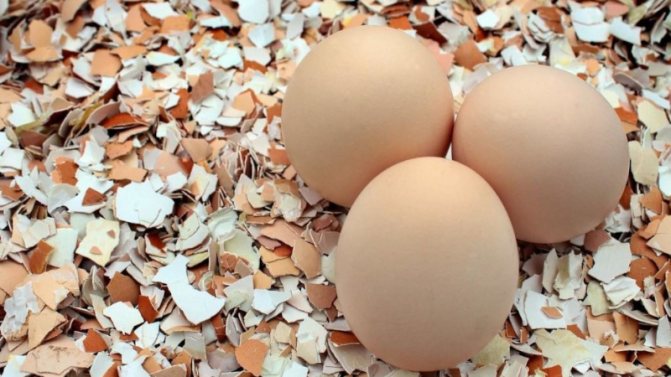
Shell collection
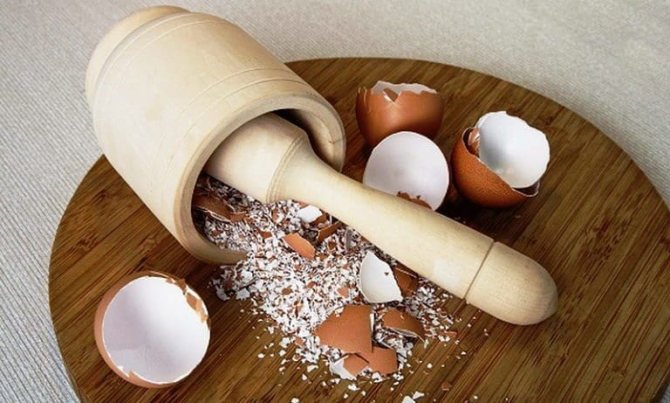

The shell is kneaded in a special mortar
In order to prepare a useful fertilizer, you will need shells from absolutely any eggs, from home eggs to store eggs. They, too, have not lost their usefulness.
It is enough to keep the shells from the eggs every time you eat them. A family of three can accumulate up to 100 shells per month, which, in terms of fertilizer, will be a fairly large amount.
Instructions for preparing shells for processing:
- Before using the egg for food, it must be carefully broken. At the same time, the shell is gently blotted and folded into a tray or spacious box.
- The shell is not closed, left to dry in this position.
- As the shell dries, it can be removed into any container intended for it. The place where this ingredient is stored should be warm, but not damp.
- If the place is chosen correctly, then in a few days the protein film will dry out and become brittle. If it is too humid around, then it will deteriorate.
- 5 days after the shells have been placed in a box or tray, they can be processed. For this, the shell is kneaded with a special mortar and packaged in paper bags.
- Raw materials can be stored in a dry place, avoiding direct sunlight.
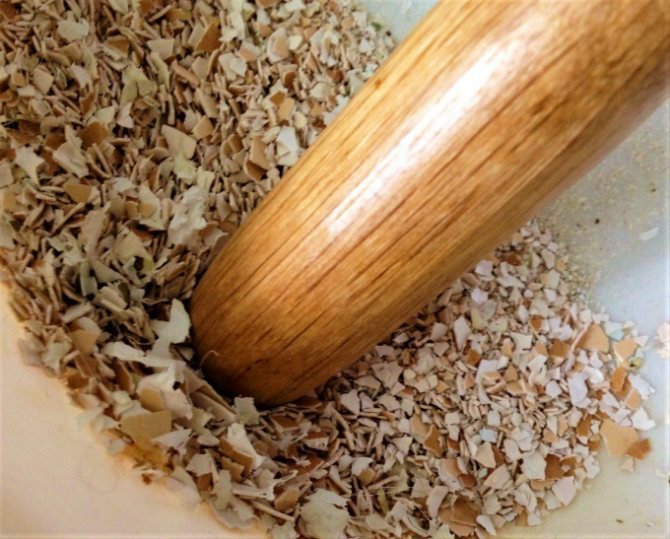

Crushing process
You can collect the shell not only from raw eggs, but also from boiled ones, it will not lose its useful properties.
How much shells will be needed in order to fertilize the beds for two weeks with an interval of 3-4 days? If we are talking about a small greenhouse or several longitudinal beds, then you will need from 100 to 200 egg shells.
Expert opinion
Chernyaeva Tatiana Dmitrievna
He is madly in love with gardening and grows only organic vegetables.
Ask a Question
If you prudently collect egg shells all year round, then you can fertilize absolutely all the plantings in your garden plot.
Why shells are useful for plants
- Egg shells reduce the acidity of the soil and improve its structure and composition. The soil becomes more alkaline, light and friable, and its air and water permeability also increases. In addition, the reduced acidity of the soil increases the fruiting of many horticultural and vegetable crops. This is especially true for clay and heavy soils.
- The structure and composition of such a product, in contrast to lime and chalk, promotes the rapid assimilation of nutrients from the soil.
- Due to the presence of calcium and magnesium in the shell, active growth of the ground part of the plant occurs, and the process of photosynthesis and metabolism improves.
- When using such fertilizer for seeds, their germination is improved and germination is increased.
- The presence of calcium in the soil contributes to the better assimilation of all nutrients from it by plants, as well as the activation of nodule bacteria, which retain nitrogen in the root zone, which is important for its growth and full development.
- Calcium strengthens the vascular walls, through which nutrients enter all parts of the plant.
- Enriches the soil with minerals.
According to research data, to neutralize the acidity of the soil, at least 0.5 kg of crushed shells should be used per 1 sq. m. If the soil is very acidic and heavy, then the dosage can be increased to 1 kg.
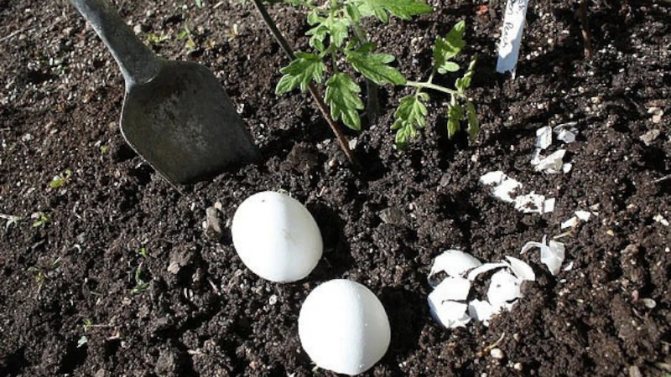

Plant growth by leaps and bounds - in the truest sense of the word
I suggest you make a plant food from the most common ingredient in pies - from yeast. Do you think I'm kidding? Not at all, even scientists investigated the wonderful properties of yeast and were convinced that the product has a positive effect on plants, contributing to rapid growth and lush development.
How to feed your pets with yeast? Prepare a simple mixture that includes:
- 5 gr. yeast (if you chose dry, then half a bag, if pressed - a quarter teaspoon);
- 35 gr. Sahara;
- half a bucket of warm water.
Stir the mixture well and let sit for a few hours. You can safely start feeding the plants, but first dilute the liquid with warm water (one and a half liters of water for a half-liter can of fertilizer). Since I have a lot of indoor pets, such a portion of yeast fertilizer diverges completely, but if you have few flowers, then you can prepare the solution in smaller quantities.
I advise you to alternate banana feeding with yeast - the result will certainly delight you!
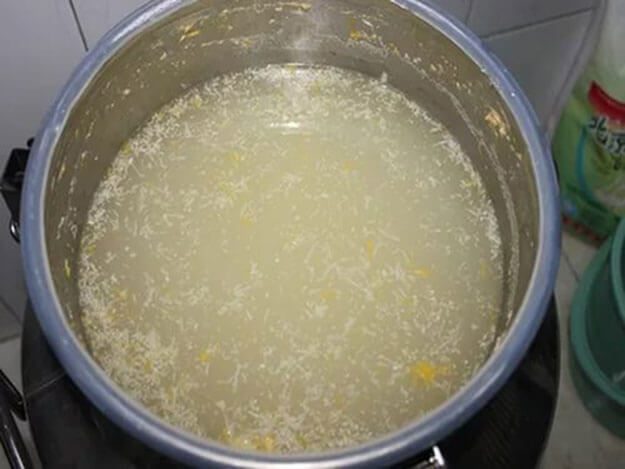

What kind of plants is this fertilizer suitable for?
As a fertilizer, eggshells are suitable for those plants that do not like soil with high acidity:
- bell pepper;
- tomatoes;
- lettuce;
- beet;
- broccoli;
- cabbage;
- melon;
- onion;
- currant;
- eggplant.
These plants prefer an alkaline environment, so they always respond well to such feeding.
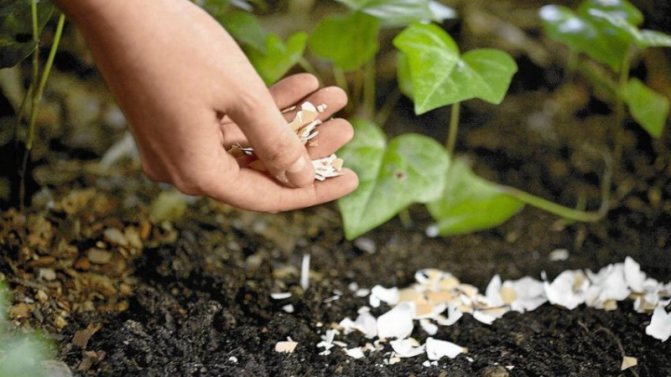

Properties
What effect can a gardener expect using such a feeding?
As previously found out, the shell contains about 92% calcium carbonate.
- It is easily absorbed by plants.
- It activates the vital activity of organisms, which allow initiating the processes of decomposition of organic matter.
- The structure and quality of the soil is improved.
- Nutrients dissolve faster.
- When feeding seedlings, the adaptation period passes faster.
- Plants harden and become hardy.
- The growth of the root system is accelerated.
- Air exchange is improved.
A similar effect is provided not only by calcium in the composition, but also by potassium, manganese, iron, phosphorus and magnesium. Together, these elements contained in the shell are capable of bringing any garden to life.
Read the related article: Calcium nitrate - nourishes, fertilizes, supplies the necessary calcium
What plants can be harmed
Shell feeding will not appeal to crops that require soil with high acidity, these include:
- Chinese cabbage;
- spinach;
- beans;
- peas;
- cucumbers;
- zucchini;
- strawberries.
The agent cannot be added to indoor flowers that grow in acidic soil:
- gloxinia;
- camellias;
- azaleas;
- gardenia;
- pelargonium;
- hydrangeas;
- violets.
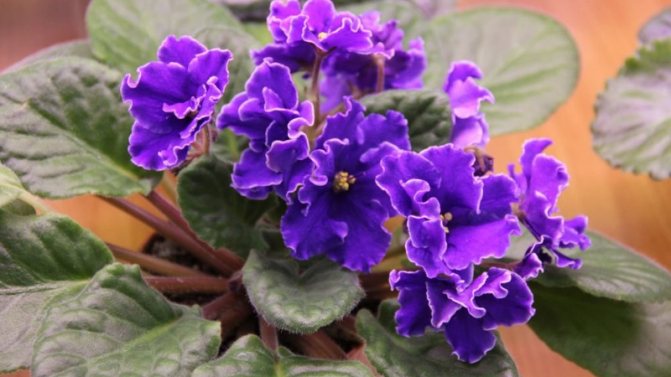

Experienced gardening tips


Agronomists often use eggshell powder even when processing large areas. This is done in situations where plants are in dire need of potassium and calcium. However, agronomists warn that if you use eggshells unnecessarily, and even in large quantities, then you run the risk of over-feeding the plants, thereby ruining the crop in the bud.
Expert opinion
Chernyaeva Tatiana Dmitrievna
He is madly in love with gardening and grows only organic vegetables.
Ask a Question
Especially do not overuse this fertilizer when it comes to flowers and plants on windowsills.
It is necessary to apply fertilizer only in those cases if the appearance and behavior of the plants speaks about it:
- growth retardation is noticed;
- plants attack pests;
- studies were carried out and high acidity of the soil was revealed;
- the culture is grown in unusual conditions for it and help is needed during planting in open ground.
Only in these cases is egg-shell feeding applicable.
If you are feeding completely healthy plants, then be careful not to overdo it. It's important to keep a fine line.
Fertilizer preparation
First of all, you need to thoroughly rinse and dry the peeling eggs. Then they are calcined in the oven for 30 minutes at a temperature of 150 degrees. After this procedure, nutrients are easier to transfer into the soil. After that, they are crushed using a blender, meat grinder, rolling pin or hammer.
Then you need to prepare the infusion. To do this, take a shell of 9-10 eggs, pour 3 liters of hot water, close the lid tightly and leave in a cool dark place for 2 weeks. When the infusion acquires a cloudy color and smell of hydrogen sulfide, it means that the fertilizer is “ripe”.
When using such an infusion, it should be diluted with water in a ratio of 1: 3.
The cleaners can be used dry, sprinkled in holes or scattered around plants. Also, fertilizers from egg peels are prepared with the addition of additional ingredients:
- onion peel;
- limestone;
- chicken droppings;
- humus;
- a piece of chalk;
- nettle;
- wood ash.
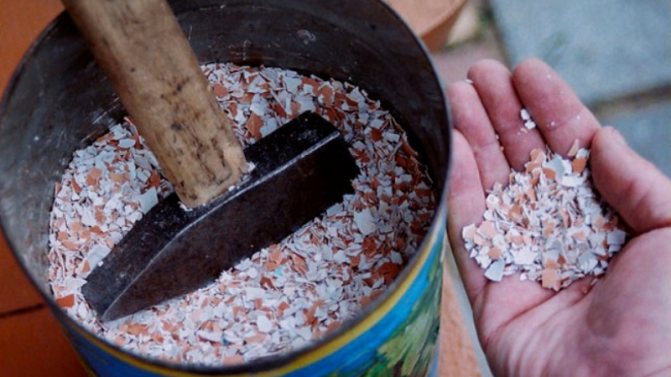

Organic fertilizing is an indispensable requirement for good plant growth.
You know perfectly well that it is to organics that plants respond with rapid growth and abundant flowering. Of course, you can go to a specialized store and purchase the necessary top dressing, but I suggest you do differently - prepare the necessary fertilizers yourself.
Here's how to use chicken droppings to provide your plants with everything they need. Take 10 grams. dried droppings and fill with water (two liters). Insist for a week, stirring the liquid regularly.
I warn you right away - you cannot use pure fertilizer, it must be diluted with plenty of water beforehand! The recommended proportion is 1:25, but I usually take a little less water.
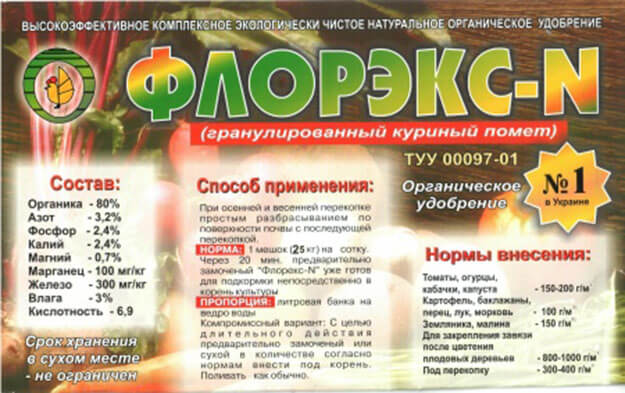

General rules for the use of fertilizers
In order for top dressing to be as effective as possible and not cause harm, you should adhere to the general rules of application:
- If the top dressing is planned to be used dry, then the shell must be crushed before adding. This will allow it to more effectively affect the soil, as well as prevent root trauma from large debris.
- Fertilizer is applied no more than once a week or even every 14 days, in order to avoid oversaturation of the soil with calcium.
- It is imperative to observe the norms of feeding: add it to the seedlings at the rate of 1 tbsp. spoon per 200 grams, and adult plants - 500 g per 1 sq. m. vegetable garden.
- If the amount of fertilizer is limited, then it is applied directly under the stem of the plant.
- When planting seedlings, 2-3 tablespoons of crushed peelings should be added to the hole.
- For the best effect, they are applied in stages: when sowing seeds, for seedlings, when planting in the ground, when feeding until an ovary is formed.
In addition, the rules of storage and preparation of cleanings should be observed so that they do not emit an unpleasant odor, and in order to prevent the growth of putrefactive bacteria. That is why the shells are thoroughly washed, dried, the inner protein film is removed and stored in a dry and dark place. It is advisable to dry them in the open air or in a room where there are drafts.
According to the recommendations of experts, top dressing is applied only until the ovaries appear. After that, it is not recommended to add the product, otherwise it may delay the ripening of the fruit.
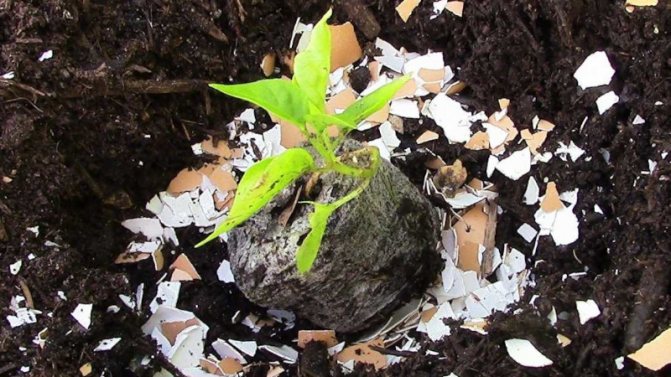

Citrus peels are a treasure trove of essential elements
If you have citrus lovers at home - tangerines, lemons or oranges, then rest assured that your plants will always be healthy and beautiful. What's the connection between tangerine lovers and your flowers? It's simple - the peel will make an excellent top dressing!
Take the peel (no difference, dry or fresh), fill the jar a little more than half, then pour warm water to the top. Infuse the fragrant liquid for a day, then strain through a colander, dilute with water (1 part citrus tincture - 3 parts water) and water the plants.
How often can citrus fertilizers be used? In winter, I cook them once a month, but in the warm season, more often - at least 2 times a month. You can alternate this with yeast or banana if you like.
How to fertilize correctly
Eggshells can be used in several ways, depending on the stage of plant development.
It can be:
- seedling seeds and or soil crops;
- grown seedlings;
- mature plants;
- indoor flowers.
Seeds
In order for seedlings to appear faster, after sowing, the seeds are sprinkled on top with crushed egg shells and only then covered with soil. The second option - a little egg shells are poured on the bottom of the container for sowing seedlings, and they are covered with earth on top. This will make the soil more nutritious.
Seedlings
Eggshells are useful in preventing rot. For example, if you add it to the soil for tomato seedlings, then the likelihood that they will get sick with apical rot is sharply reduced, since this disease occurs due to a lack of calcium in the soil.
In addition, it is recommended to dust the seedlings with crushed egg peels in order to prevent blackleg disease, while the shell should be crushed to a dust state.
It has been noted that egg peels can be harmful to young seedlings (before the appearance of the 3rd true leaf).
Another method of using eggshells for seedlings is to create "cups" from them for sowing seeds. You can make small pots from the halves of the shells, fill them with soil and sow seeds. So they will additionally receive useful substances. And you can plant seedlings together with egg cups, since when the roots grow in the soil, they will decay.
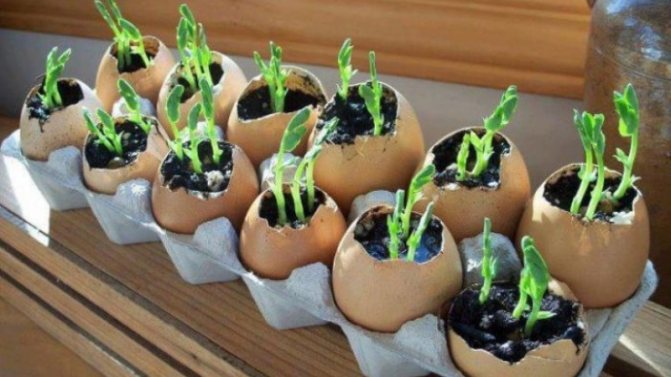

Top dressing of mature plants
When fertilizing adult plants, eggshells are added to the wells to saturate the soil with calcium and nutrients.
To do this, use an infusion of eggshells and water, aged for at least 5-7 days. Before use, it is diluted with water in a ratio of 1: 3 and poured into the wells in an amount of not more than 0.5 liters of solution for each.
The tool is used for feeding:
- bell pepper;
- eggplant;
- beets;
- tomatoes and other vegetables.
Dry shells are used for feeding:
- Luke;
- potatoes;
- carrots.
Indoor flowers
To fertilize indoor flowers, eggshells are used as an infusion or in dry crushed form. It is also suitable for creating a system for removing excess fluid from the roots. To do this, crushed shells are placed on the bottom of the flower pot with a layer of 2-3 cm, then soil is poured and the plants are planted. This drainage method allows for normal fluid circulation and does not allow water to stagnate and provoke rot in the roots. Even as a drainage system, the eggshell works as fertilizer, releasing calcium and other elements into the soil.
Gardeners note that it is advisable to use eggshells in the form of an infusion, this method is more effective and gives better results.
Watering the plant with such an infusion should be no more than once a week, a few hours before the main watering.
Before preparing the infusion or pouring the shell into the pots, it must be calcined in the oven.
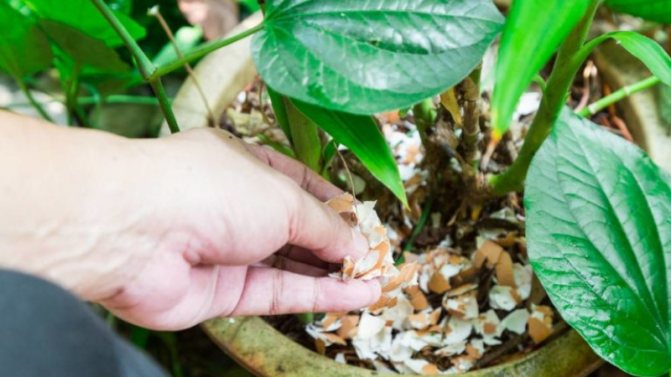

The secret to the effectiveness of the recipe
Various liquid extracts and granular fertilizers can also show excellent results. They can cause accelerated growth or increased fruiting by increasing the concentration of vitamins in plant tissues. But the soil does not get better from this. And the option of fertilizing the soil with egg whites will have a longer lasting effect with an extended spectrum of action.
What is the secret of such effectiveness of the egg whites infusion is not advertised. It is also not easy to find scientific papers on this topic. Therefore, ordinary lovers of taking care of their green pets can only trust the advice of their ancestors and build all sorts of guesses. According to one opinion, the secret of this recipe lies in the composition of the egg white. In addition to water, proteins, oil and carbohydrates, it contains a variety of enzymes, B vitamins and glucose.
It is glucose that is considered a very important, even vital, substance for home flowers.
After all, it is not only a universal building material from which complex molecules of organic substances such as cellulose, lipids, starch, proteins and nucleic acids are formed. In addition, glucose carries deposits of energy necessary for growth, respiration, nutrition, fruiting, reproduction and other vital processes of plants.
Eggshell garden recipes
There are many recipes for fertilizers using eggshells. The main pole of such dressings is that they:
- time-tested;
- are not toxic;
- safe;
- give good results.
Eggshell and Ash Blend
It is necessary to mix the shell (pre-calcined in the oven and crushed) and wood ash in a ratio of 1: 2, respectively.
Gardeners note that such a mixture gives incredible results: the plants become strong, significantly increase in growth, and their productivity also increases.
The mixture is scattered over the beds in a thin layer, then poured abundantly with water. The procedure is carried out 1-2 times a week for a month.
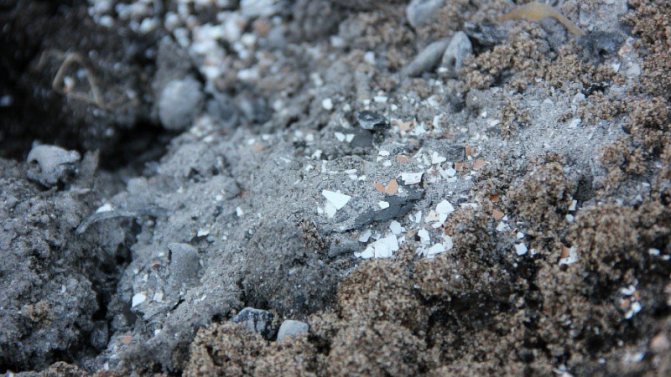

With limestone
If you need not just to reduce the acidity of the soil, but to feed the plants, then the eggshell is mixed with limestone in a 1: 1 ratio and diluted with water to a liquid state. After that, root top dressing of garden crops is performed.
Mixing with humus
The humus is diluted with water to the desired concentration, and then crushed shells are added per 10 liters of diluted humus - 1 liter can.
Egg shell mulching
A great way to get rid of pests such as slugs, snails, bears. To do this, it is enough to grind the shell well and scatter it around the plants. This will become a kind of obstacle on the way of pests and soon they will stop attacking plants.
When mulching, keep in mind that the shells can attract birds, and they can also harm the crop.
Abroad, eggshells are often used both as independent feeding and as an auxiliary component of natural fertilizers. In addition, it is an excellent remedy for combating plant parasites and diseases.
Using wood ash to prepare top dressing
I want to tell you right away that the main component, without which neither vegetable crops nor indoor plants can do without, is wood ash. I believe that this substance contains the elements necessary for excellent development and growth, therefore I use ash not only for preparing substrates, but also as the main element of fertilization.
Preparing top dressing will not cause you any difficulties, because you just need to mix:
- 3 handfuls of wood ash;
- 4 liters of water.
Insist liquid for about a week (not less!), And then feed your pets. It is not necessary to dilute with water, the fertilizer is completely ready for use. I advise only to thoroughly moisten the soil mixture in the pots beforehand. Top dressing can be used even in winter - even during the dormant period, plants are stocked with useful elements for good growth with the arrival of spring.
Soil mulching
We use eggs to prepare our meals almost every day. If not scrambled eggs, then for salads or baked goods. Therefore, even during the winter, you can accumulate a certain amount of shells.
If you grind it, not necessarily to the state of flour, and sprinkle the tree-trunk circles of fruit trees or beds, you get an excellent mulch. It will not quickly rot or dissolve. But it will prevent the soil from drying out, will nourish the soil with useful substances, and prevent the growth of weeds.
Calcium in the shell of an egg is a natural mineral that helps in growing plants
Why does eggshells benefit plants? It is no secret that any agricultural crop or flower is very responsive to the content of various trace elements in the soil. Fertilizers not only stimulate the growth of flowers and vegetables, but also increase their yield. Eggshells contain huge amounts of calcium carbonate. This chemical element promotes the growth of aboveground parts of plants, plays an important role in the process of photosynthesis, enhances metabolism in tissues, and accelerates the consumption of storage proteins in seeds during their germination.
Most of all, it is consumed by crops with a large mass of aboveground organs. In addition to calcium, the fertilizer contains 27 more chemical elements in the form of eggshells. The most important of them are: copper, iron, potassium, manganese, fluorine, sulfur, phosphorus, selenium, silicon, zinc, molybdenum.
Pest and disease control
But the introduction into the soil in the form of pieces of shell, for example, when digging the earth, can protect the roots of plants from the invasion of rodents. It may not be so effective against moles, since the scattered pieces of shell are unlikely to scare them, they will dig a passage nearby. But the bear will be afraid of its sharp corners and is unlikely to come back to this place.
They will well protect the scattered shells from slugs. They are scattered around the cabbage, sharp edges will be extremely unpleasant for them, and they will not be able to get on the cabbage leaves and will not come again.
Our grandmothers used shells against white butterflies. They hung the halves on pegs. The butterflies laid their eggs on their shells, which were then burned.
It is good to sprinkle the seedlings with the ash flour with egg flour, it perfectly helps to fight the "black leg".
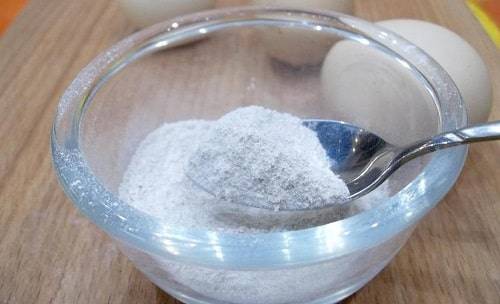

Benefit, harm and application
Fertilization should be treated with great care. Given that the shell reduces the acidity of the soil, it is unacceptable to add it under flowers that are suitable for acidic soil.
Houseplants that should not be fed with shell fertilizer:
They respond well to making such a top dressing:
- heliotrope;
- abutilone;
- room tradescantia;
- some types of ficus;
- palm trees;
- begonia;
- primroses;
- chrysanthemums.
Egg husks contain 93% calcium, iron, zinc, phosphorus, copper and potassium. If you follow the watering rate and the timing of feeding flowers using the shell, then they will receive those nutrients that are needed for healthy growth and development.
The egg powder obtained by grinding can be mixed with the soil. For a medium-sized pot, take 1 tablespoon of powder, there is a large container, then the amount is increased. Sprinkle this mixture over the soil in the pots. The shell decomposes quickly, thanks to this property the plant will receive nutrients and grow.
Plant nutrition
No matter how we use eggshells, for deoxidation or mulching, pest control, the plants themselves are nourished at the same time.Crushed to the state of flour, the shells nourish the plant with trace elements, so necessary for nutrition and development. Remember that fertilizer will not work immediately, but gradually over several years.
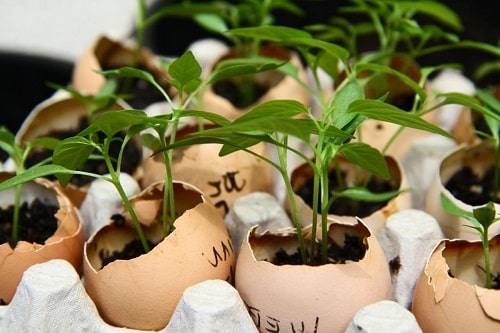

Egg feeding at home
In addition to the undoubted benefits of the shell and its availability, an important plus is that it is not at all difficult to prepare the future fertilizing for flowers and it will not take much time. The main thing here is to prepare the eggs (or rather, what remains of them), and you can proceed. There are several ways to make fertilizer at home from such a valuable ingredient. But one thing remains unchanged - only the shell of raw eggs is suitable as a top dressing, boiled ones already lose most of their benefits.
How to improve yields? We are constantly receiving letters in which amateur gardeners are worried that due to the cold summer this year there is a poor harvest of potatoes, tomatoes, cucumbers, and other vegetables. Last year we published TIPS on this matter. But unfortunately, many did not listen, but some still applied. Here is a report from our reader, we want to advise plant growth biostimulants that will help increase the yield up to 50-70%.
We advise you to prepare in advance for the summer season, pay attention to this biological product. There are a lot of positive responses.
Read ...
- The easiest option is shells crushed in a coffee grinder or manually. It can be mixed with soil prepared for planting. Or pour the shells onto the surface of the ground (about a third of a teaspoon per pot). Then, when watering, useful substances will flow to the roots of flowers. But the first option is preferable, since the egg shell will gradually decompose in the ground, quickly giving off trace elements to flowers. By the way, many experienced flower growers advise to rinse the shell well before using it and dry it a little in the oven. This allows you to destroy possible pathogenic microorganisms, which can subsequently lead to root rot.
- Shell infusion. It is believed that in this way the eggs completely give all the benefits to the water, and there is no risk of the reproduction of harmful microorganisms if the workpiece has not been properly processed. To get a liquid fertilizer for plants at home, you need to pour the crushed (preferably powder) shell from five eggs with a liter of boiled water. Cooking infusion from the shell
Leave the mixture for five days, stirring occasionally. The resulting solution must be watered indoor plants in the usual manner. You can dissolve a little sugar in this infusion - such a remedy will be very useful for young plants. The glucose contained in such a solution will help new shoots develop, and calcium will make them stronger. - An interesting enough option for using eggshells is to plant young shoots in it. If you need to propagate an adult plant, then cuttings that have already given roots can be planted not in a pot, but in the remains of an egg. So young shoots will receive the calcium they need for growth, and with the subsequent transplant they will already be strong enough. You can use either half of the shell as a temporary pot for plants, or even better - carefully removing only the top. Several small holes should be made at the base to drain moisture, then pour soil into a temporary shelter and plant a flower. When the plant becomes strong, strong and gains a powerful root system, you can already plant it in the main pot. It is not necessary to remove it from the shell, it is even better to leave it for further fertilization of the soil. Only a temporary pot should be kneaded a little before planting in the ground, so that it is easier for the plant to break through the shell, and so it will begin to decompose faster, giving all the benefits to the sprout.
- Some growers believe that it is useful to use the water that remains after boiling the eggs. Supposedly, it contains mineral salts that are so useful to plants. How true this information is is unknown. In any case, there will be no harm. But you can reuse water, while saving your finances.
Shell - universal soil fertilizer
Similar methods of feeding indoor flowers can be used on their own or mixed with other substances. It is only necessary to observe the dosage and frequency of fertilization. Additional nutrition for plants is usually required from March to October, when the flowers enter the stage of active growth.
More feeding is needed after transplanting and pruning. The rest of the time, plants only need watering. Excess fertilizers can lead to disease, and subsequently to the death of flowers. Therefore, you should carefully monitor the condition of your wards in order to take the necessary measures in time.
Signs of excess and lack of essential substances
In addition to constantly feeding houseplants, the shell can also be used to compensate for the lack of certain substances. The main thing is, of course, calcium, which, as you know, is rich in the shell of eggs. But other substances can also be obtained from it. True, their number is still not as large as required for a full-fledged diet, and an additional source is needed, for example, phosphorus, magnesium or nitrogen.
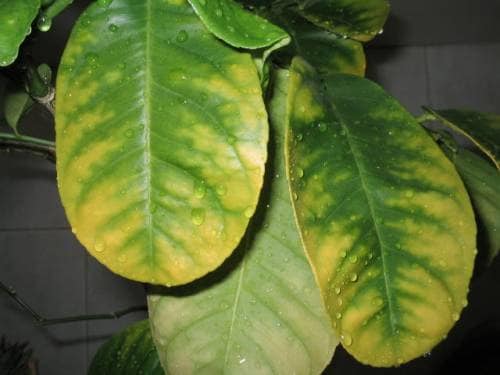

Signs of calcium deficiency in the "green pet"
But before trying to fill this deficiency, you should understand that it still exists. If the flowers lack calcium, then the following points will talk about this:
In general, the lack of this element is easy to notice. He is responsible for the vitality and strength of the shoots, and the lack of calcium instantly makes a beautiful plant something sick and dull. Gradually, the death of a flower may occur, if the necessary measures are not taken in time. That is, it is necessary to start fertilizing with compounds containing the necessary elements in large quantities. And this is where the shell will help.
But you also need to be more careful with enhanced calcium supplementation. An excess of this substance is harmful to plants. If the leaves begin to turn yellow on the flowers, and the veins, at the same time, become dark, then, most likely, it is worth limiting the feeding with mixtures containing this substance.
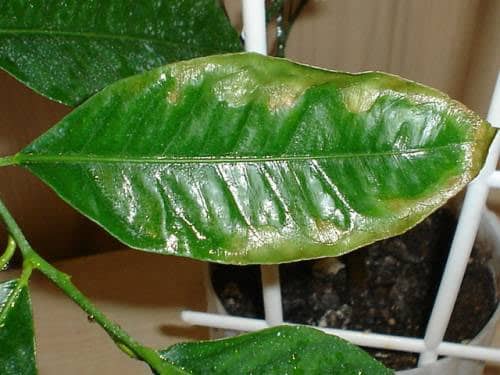

Signs of an excess of calcium in a houseplant
In addition to deteriorating the general condition and appearance of indoor flowers, calcium interferes with the absorption of other trace elements. From here, spots may appear on the leaves, a change in color, shape, bud fall, curvature of shoots and other negative manifestations - which means that the flower lacks some nutrients. And it is not at all necessary to increase the feeding. It might just be worth cutting back on supplemental calcium supplements.
Definitely, we can conclude that eggshells are very useful for indoor flowers. At the same time, it is also practically free fertilizer that can be made quickly at home. But to apply it, like any other top dressing, you should be careful, not zealous. Otherwise, instead of beautiful plants, you can get stunted and sick, which then have to be restored for a long time.
If you immediately start caring for your pets correctly, keeping a balance in everything, there will be no problems with flowers. Except for one - where to find a place for new pets. After all, when everything works out and the result of care is visible, you want to acquire more and more new potted plants.
Waste from our table: soil fertilizer from shells
And a little about the secrets of the Author
Have you ever experienced unbearable joint pain? And you know firsthand what it is:
- inability to move easily and comfortably;
- discomfort when going up and down stairs;
- unpleasant crunching, clicking not on their own;
- pain during or after exercise;
- joint inflammation and swelling;
- unreasonable and sometimes unbearable aching pain in the joints.
Now answer the question: does this suit you? How can you endure such pain? And how much money have you already "poured" on ineffective treatment? That's right - it's time to end it! Do you agree? That is why we decided to publish an exclusive interview with Oleg Gazmanov, in which he revealed the secrets of getting rid of joint pain, arthritis and arthrosis.
Caveats
Very often, the cause of the death of certain varieties of plants is the banal ignorance of gardeners. For example, there are varieties and individual crops that prefer acidic soil. It is suitable for many flowers and houseplants. Other crops do not grow well in alkaline soil. That is why they need to be well watered and loosened.
However, if you start to reduce the acidity of the soil, the plants may not respond well. They become lethargic, they will hurt, and if you do not notice the reaction for a long time, death is possible. This applies to some varieties of cucumbers, pumpkins and many ornamental flowers.
Expert opinion
Chernyaeva Tatiana Dmitrievna
He is madly in love with gardening and grows only organic vegetables.
Ask a Question
Do not scatter large pieces of shells among the plants.
- First, you can injure crops, which is fraught with various infections, and so on.
- Secondly, such a shell takes a very long time to transform into fertilizer, and most likely, the plants will not benefit from it. Therefore, it is better to grind the eggshells into powder.
The shell must not be left uncovered. Many people try to scatter the powder over the beds before the digging procedure. It is important not to leave the shell on the surface, but to dig it into the soil. Otherwise, you can attract birds, and as a result, you lose the entire crop.
Growing seedlings
And here the shells will be of use to us. First, in the shells filled with nutritious soil, you can plant seeds for seedlings. As it grows, the seedlings are planted in the ground or in seedling boxes along with the shell. True, first you need to break the lower side with a spoon so that it cracks and the roots of the plant can grow further.
Secondly, calcium carbonate activates seed growth due to the proteins contained in the seeds. Thirdly, you can save on containers for growing seedlings. Even the cardboard cages in which eggs are sold can be used profitably by putting the same shells with seedlings there.


